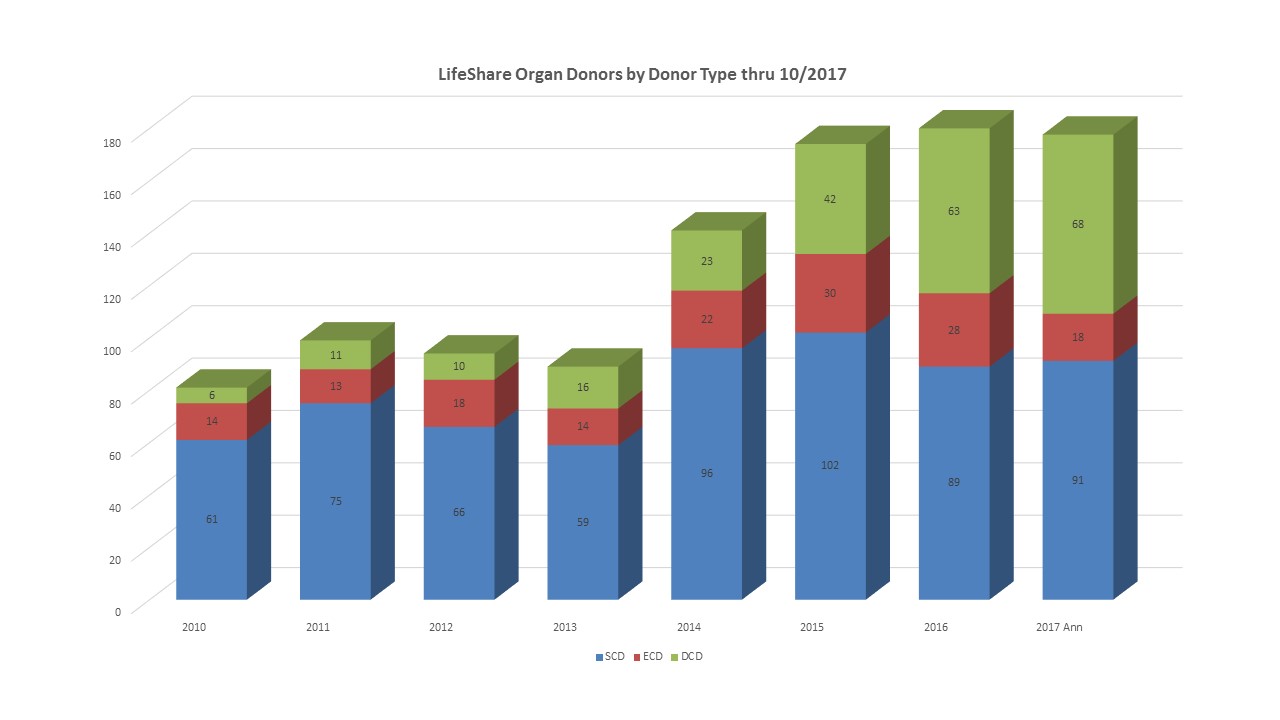Does Rapid Growth in the Number of Donation after Circulatory Death Donors Equate to Fewer Brain Dead Donors and Fewer Organs Transplanted?
Jeffrey P Orlowski1, Janice F Whaley1, Chad Trahan1, Chad C Muse1, Ronald A Squires1.
1LifeShare Transplant Donor Services of Oklahoma, Oklahoma City, OK, United States
Background: One U.S. organ procurement organization (OPO) saw a significant growth in donation after circulatory death (DCD) as a percentage of its overall deceased donor population between 2012 and 2017. Growing the number of DCD donors recovered was a strategy undertaken in 2012 to increase overall OPO performance. The OPO sought to identify whether the DCD increase had unintentionally impacted brain dead donors (DBD) recovered and/or the total number of organs transplanted.
Method: A retrospective review of donation activity was performed from 2012-2017 (2017 annualized based upon 10 months’ data). Donor types and organs transplanted were analyzed. Trends in data were analyzed both year-to-year and by comparing 2017 to mean data over the OPO's growth cycle (defined as 2014 to 2017).
Results: From 2012 to 2017, the OPO experienced an increase in total deceased organ donors from 94 to 178 (+89.4%) with a peak of 180 donors in 2016. For the same period, total DBD increased from 84 to 109 (+29.8%) with a peak of 132 in 2015. DCD increased from 10 to 68 (+680%), peak=68 in 2017. With DBD donors subdivided into standard criteria donors (SCD) and extended criteria donors (ECD), results are: SCD increased from 66 to 91 (+37.9%) with a peak of 102 SCD in 2015 while ECD remained flat at 18 in both 2012 and 2017 with a peak of 30 ECD in 2015. Similarly, organs transplanted (OTx) from all deceased donors increased from 323 to 509 (+57.6%), peak=509 in 2017; from DCD OTx increased from 20 to 132 (+660%), peak=132 in 2017; from SCD OTx increased from 262 to 343 (+30.9%), peak=361 in 2014; and from ECD OTx decreased from 41 to 34 (-17.1%), peak=54 in 2015.
Similarly, organs transplanted (OTx) from all deceased donors increased from 323 to 509 (+57.6%), peak=509 in 2017; from DCD OTx increased from 20 to 132 (+660%), peak=132 in 2017; from SCD OTx increased from 262 to 343 (+30.9%), peak=361 in 2014; and from ECD OTx decreased from 41 to 34 (-17.1%), peak=54 in 2015.
Discussion: In this OPOs experience, accomplishing significant growth in DCD was initially (through 2015) accomplished in parallel with increases in both SCD and ECD. However, in the most recent two years, both SCD and ECD have declined from 2015 peaks (-10.8% and -40.0% respectively). SCD have remained relatively in-line with a four year (2014-2017) mean of 94 (-3.2%) but ECD have declined from a four year mean of 24.5 to 18 (-26.5%). Similarly, OTx from SCD have remained relatively in line with a four year mean of 349.6 (-1.9%) whereas ECD OTx have decreased from a four year mean of 43.3 (-21.5%). Though total deceased donors and OTx have been steadily up, recently DCD donors and OTx continue to increase as DBD have been declining, especially in the ECD population. While the OPO authorizes all DCD donors for DBD also, and routinely some DCD progress to DBD prior to recovery (at which time organs are re-allocated), the overall DBD decrease and the profound ECD decrease could result from a variety of variables such as more rapid deceleration of care and bears further study. A broader, multi-OPO study is also indicated to determine if this is a national trend, and whether local and regional variables impacting any trend are unique depending on donor locale.
